Free Culture: Copyright, Piracy, and the Impact on Music Industry
VerifiedAdded on 2020/05/28
|5
|1191
|289
Essay
AI Summary
This essay explores the concepts of free culture, copyright, and piracy, particularly within the context of the music industry. It begins by defining copyright and its implications for creative works, including cover songs and music sampling, highlighting how copyright restricts the reproduction and reuse of musical pieces. The essay then addresses the issue of digital piracy, examining its prevalence and the ineffectiveness of copyright laws in preventing unauthorized use of copyrighted material. It discusses the role of peer-to-peer networks and cyberlocker services in facilitating piracy, and the challenges copyright owners face in combating it. The essay references relevant literature to support its arguments, providing a comprehensive overview of the complex relationship between copyright, creative expression, and the challenges of digital distribution.
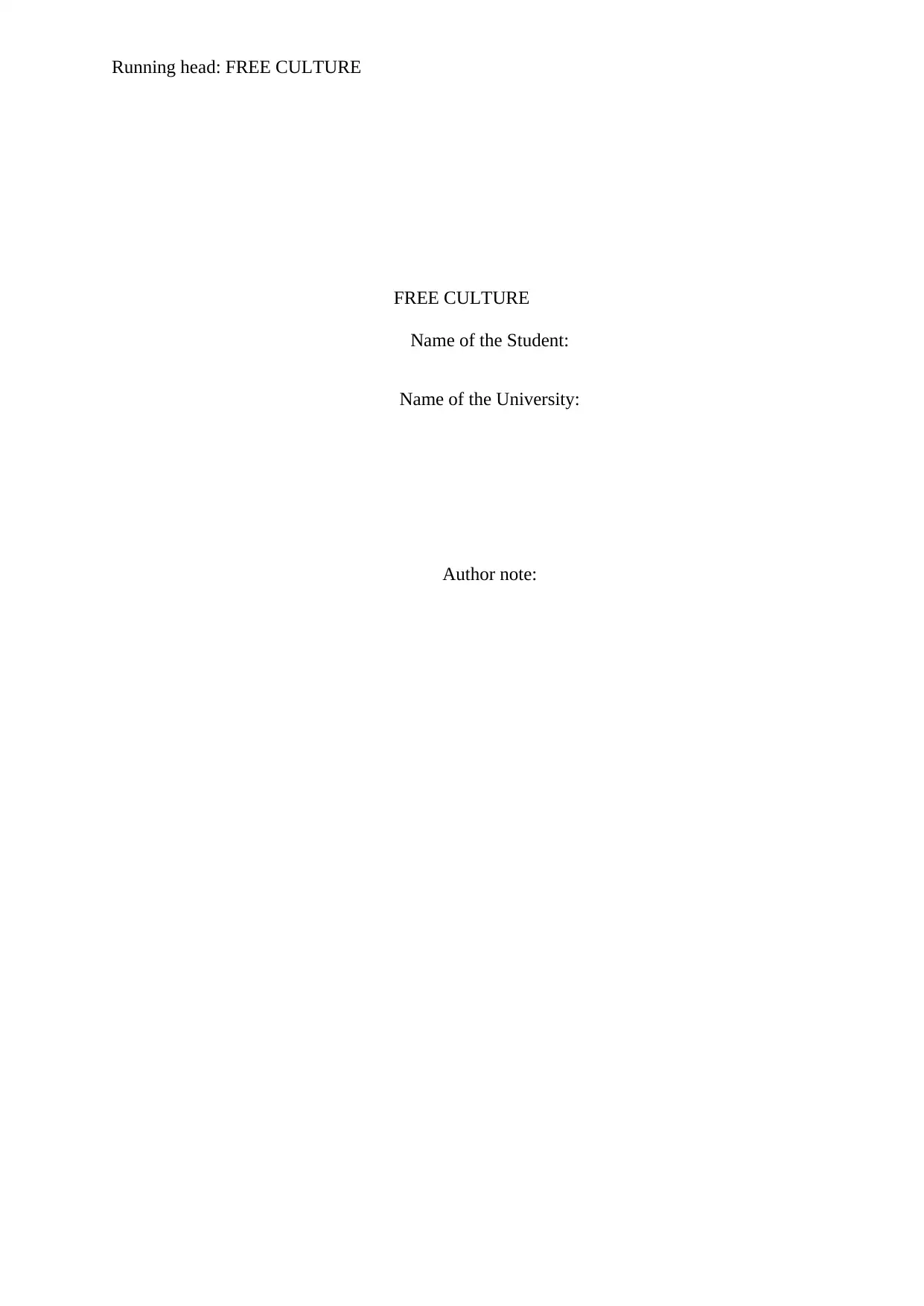
Running head: FREE CULTURE
FREE CULTURE
Name of the Student:
Name of the University:
Author note:
FREE CULTURE
Name of the Student:
Name of the University:
Author note:
Paraphrase This Document
Need a fresh take? Get an instant paraphrase of this document with our AI Paraphraser
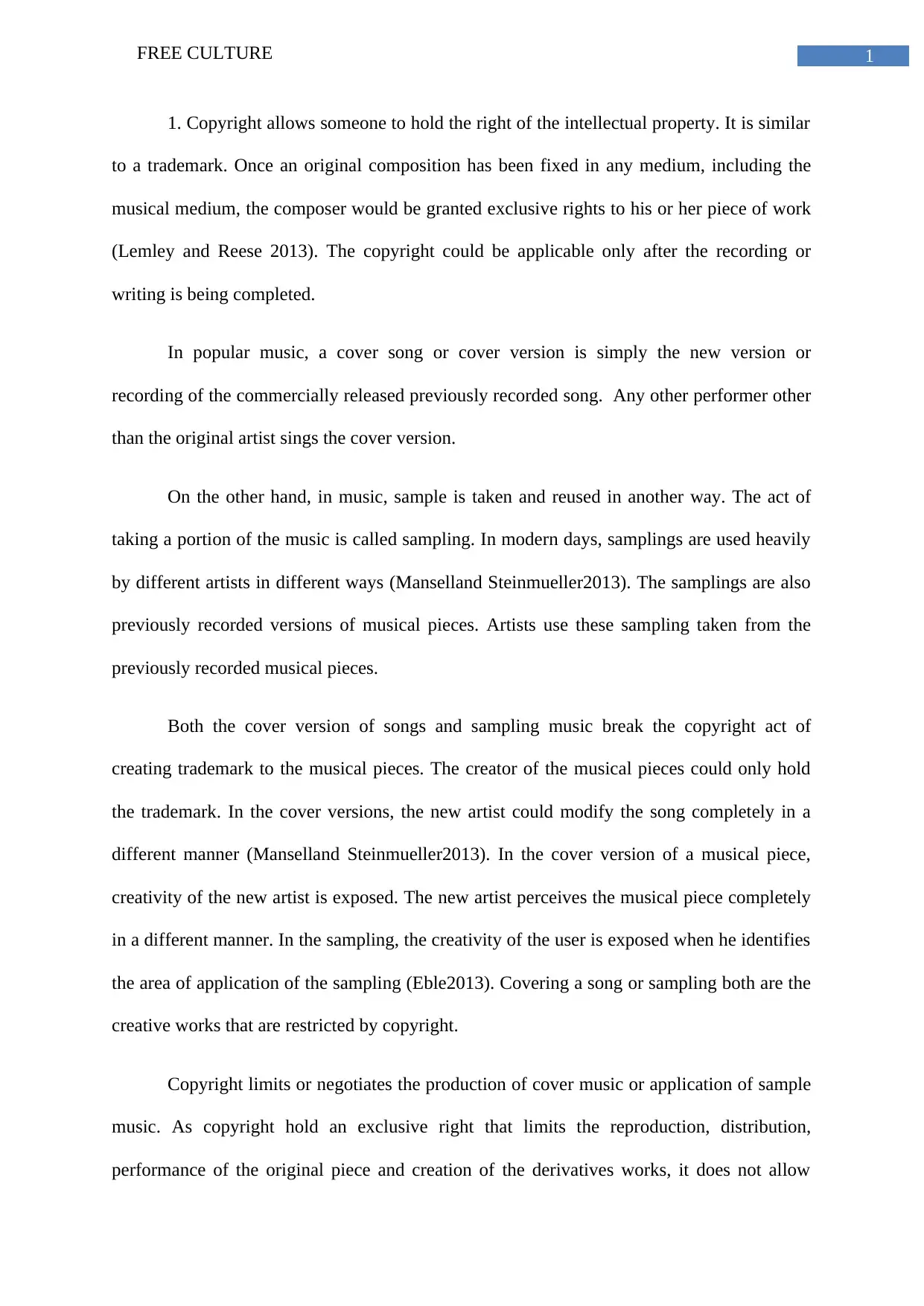
1FREE CULTURE
1. Copyright allows someone to hold the right of the intellectual property. It is similar
to a trademark. Once an original composition has been fixed in any medium, including the
musical medium, the composer would be granted exclusive rights to his or her piece of work
(Lemley and Reese 2013). The copyright could be applicable only after the recording or
writing is being completed.
In popular music, a cover song or cover version is simply the new version or
recording of the commercially released previously recorded song. Any other performer other
than the original artist sings the cover version.
On the other hand, in music, sample is taken and reused in another way. The act of
taking a portion of the music is called sampling. In modern days, samplings are used heavily
by different artists in different ways (Manselland Steinmueller2013). The samplings are also
previously recorded versions of musical pieces. Artists use these sampling taken from the
previously recorded musical pieces.
Both the cover version of songs and sampling music break the copyright act of
creating trademark to the musical pieces. The creator of the musical pieces could only hold
the trademark. In the cover versions, the new artist could modify the song completely in a
different manner (Manselland Steinmueller2013). In the cover version of a musical piece,
creativity of the new artist is exposed. The new artist perceives the musical piece completely
in a different manner. In the sampling, the creativity of the user is exposed when he identifies
the area of application of the sampling (Eble2013). Covering a song or sampling both are the
creative works that are restricted by copyright.
Copyright limits or negotiates the production of cover music or application of sample
music. As copyright hold an exclusive right that limits the reproduction, distribution,
performance of the original piece and creation of the derivatives works, it does not allow
1. Copyright allows someone to hold the right of the intellectual property. It is similar
to a trademark. Once an original composition has been fixed in any medium, including the
musical medium, the composer would be granted exclusive rights to his or her piece of work
(Lemley and Reese 2013). The copyright could be applicable only after the recording or
writing is being completed.
In popular music, a cover song or cover version is simply the new version or
recording of the commercially released previously recorded song. Any other performer other
than the original artist sings the cover version.
On the other hand, in music, sample is taken and reused in another way. The act of
taking a portion of the music is called sampling. In modern days, samplings are used heavily
by different artists in different ways (Manselland Steinmueller2013). The samplings are also
previously recorded versions of musical pieces. Artists use these sampling taken from the
previously recorded musical pieces.
Both the cover version of songs and sampling music break the copyright act of
creating trademark to the musical pieces. The creator of the musical pieces could only hold
the trademark. In the cover versions, the new artist could modify the song completely in a
different manner (Manselland Steinmueller2013). In the cover version of a musical piece,
creativity of the new artist is exposed. The new artist perceives the musical piece completely
in a different manner. In the sampling, the creativity of the user is exposed when he identifies
the area of application of the sampling (Eble2013). Covering a song or sampling both are the
creative works that are restricted by copyright.
Copyright limits or negotiates the production of cover music or application of sample
music. As copyright hold an exclusive right that limits the reproduction, distribution,
performance of the original piece and creation of the derivatives works, it does not allow
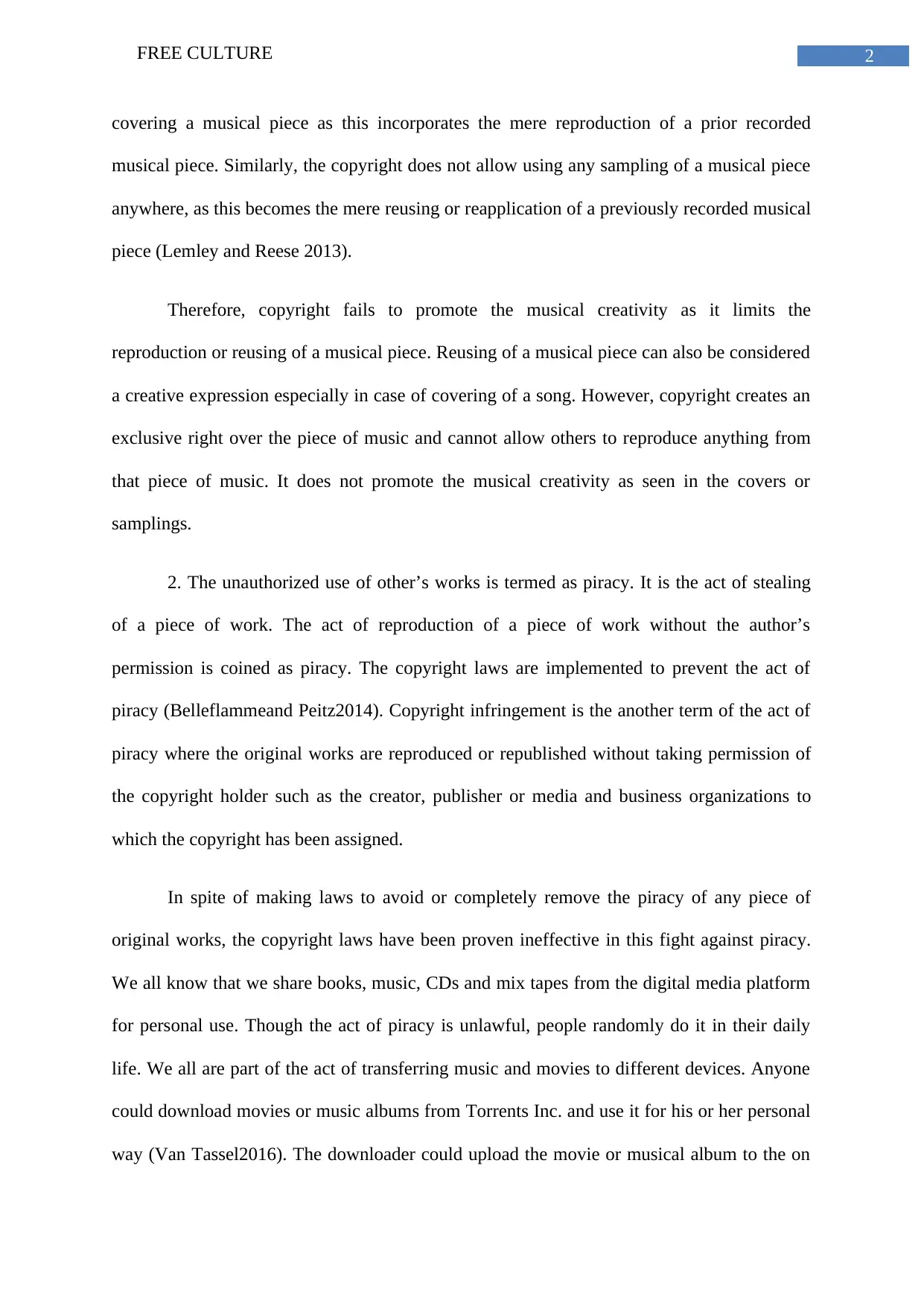
2FREE CULTURE
covering a musical piece as this incorporates the mere reproduction of a prior recorded
musical piece. Similarly, the copyright does not allow using any sampling of a musical piece
anywhere, as this becomes the mere reusing or reapplication of a previously recorded musical
piece (Lemley and Reese 2013).
Therefore, copyright fails to promote the musical creativity as it limits the
reproduction or reusing of a musical piece. Reusing of a musical piece can also be considered
a creative expression especially in case of covering of a song. However, copyright creates an
exclusive right over the piece of music and cannot allow others to reproduce anything from
that piece of music. It does not promote the musical creativity as seen in the covers or
samplings.
2. The unauthorized use of other’s works is termed as piracy. It is the act of stealing
of a piece of work. The act of reproduction of a piece of work without the author’s
permission is coined as piracy. The copyright laws are implemented to prevent the act of
piracy (Belleflammeand Peitz2014). Copyright infringement is the another term of the act of
piracy where the original works are reproduced or republished without taking permission of
the copyright holder such as the creator, publisher or media and business organizations to
which the copyright has been assigned.
In spite of making laws to avoid or completely remove the piracy of any piece of
original works, the copyright laws have been proven ineffective in this fight against piracy.
We all know that we share books, music, CDs and mix tapes from the digital media platform
for personal use. Though the act of piracy is unlawful, people randomly do it in their daily
life. We all are part of the act of transferring music and movies to different devices. Anyone
could download movies or music albums from Torrents Inc. and use it for his or her personal
way (Van Tassel2016). The downloader could upload the movie or musical album to the on
covering a musical piece as this incorporates the mere reproduction of a prior recorded
musical piece. Similarly, the copyright does not allow using any sampling of a musical piece
anywhere, as this becomes the mere reusing or reapplication of a previously recorded musical
piece (Lemley and Reese 2013).
Therefore, copyright fails to promote the musical creativity as it limits the
reproduction or reusing of a musical piece. Reusing of a musical piece can also be considered
a creative expression especially in case of covering of a song. However, copyright creates an
exclusive right over the piece of music and cannot allow others to reproduce anything from
that piece of music. It does not promote the musical creativity as seen in the covers or
samplings.
2. The unauthorized use of other’s works is termed as piracy. It is the act of stealing
of a piece of work. The act of reproduction of a piece of work without the author’s
permission is coined as piracy. The copyright laws are implemented to prevent the act of
piracy (Belleflammeand Peitz2014). Copyright infringement is the another term of the act of
piracy where the original works are reproduced or republished without taking permission of
the copyright holder such as the creator, publisher or media and business organizations to
which the copyright has been assigned.
In spite of making laws to avoid or completely remove the piracy of any piece of
original works, the copyright laws have been proven ineffective in this fight against piracy.
We all know that we share books, music, CDs and mix tapes from the digital media platform
for personal use. Though the act of piracy is unlawful, people randomly do it in their daily
life. We all are part of the act of transferring music and movies to different devices. Anyone
could download movies or music albums from Torrents Inc. and use it for his or her personal
way (Van Tassel2016). The downloader could upload the movie or musical album to the on
⊘ This is a preview!⊘
Do you want full access?
Subscribe today to unlock all pages.

Trusted by 1+ million students worldwide
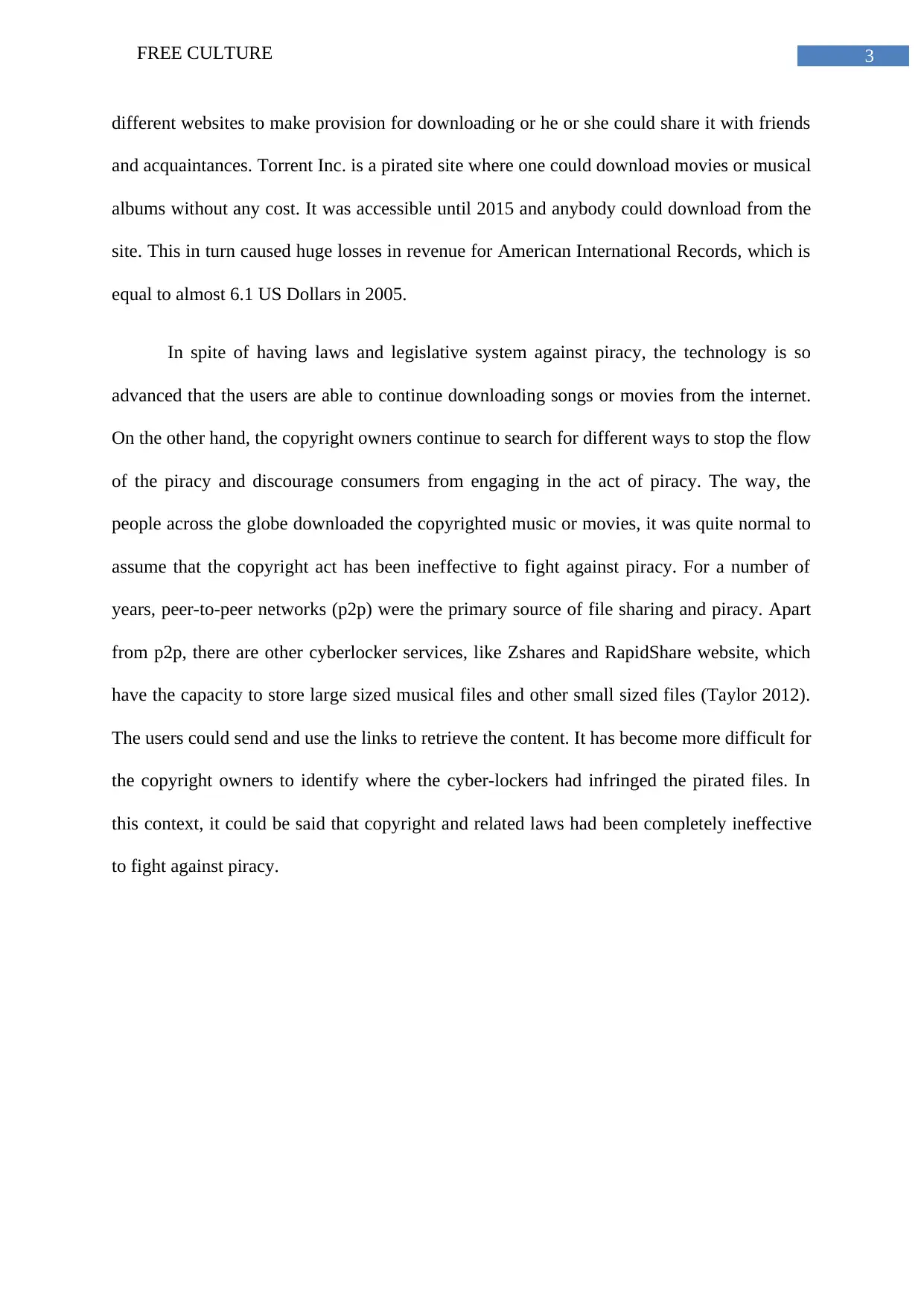
3FREE CULTURE
different websites to make provision for downloading or he or she could share it with friends
and acquaintances. Torrent Inc. is a pirated site where one could download movies or musical
albums without any cost. It was accessible until 2015 and anybody could download from the
site. This in turn caused huge losses in revenue for American International Records, which is
equal to almost 6.1 US Dollars in 2005.
In spite of having laws and legislative system against piracy, the technology is so
advanced that the users are able to continue downloading songs or movies from the internet.
On the other hand, the copyright owners continue to search for different ways to stop the flow
of the piracy and discourage consumers from engaging in the act of piracy. The way, the
people across the globe downloaded the copyrighted music or movies, it was quite normal to
assume that the copyright act has been ineffective to fight against piracy. For a number of
years, peer-to-peer networks (p2p) were the primary source of file sharing and piracy. Apart
from p2p, there are other cyberlocker services, like Zshares and RapidShare website, which
have the capacity to store large sized musical files and other small sized files (Taylor 2012).
The users could send and use the links to retrieve the content. It has become more difficult for
the copyright owners to identify where the cyber-lockers had infringed the pirated files. In
this context, it could be said that copyright and related laws had been completely ineffective
to fight against piracy.
different websites to make provision for downloading or he or she could share it with friends
and acquaintances. Torrent Inc. is a pirated site where one could download movies or musical
albums without any cost. It was accessible until 2015 and anybody could download from the
site. This in turn caused huge losses in revenue for American International Records, which is
equal to almost 6.1 US Dollars in 2005.
In spite of having laws and legislative system against piracy, the technology is so
advanced that the users are able to continue downloading songs or movies from the internet.
On the other hand, the copyright owners continue to search for different ways to stop the flow
of the piracy and discourage consumers from engaging in the act of piracy. The way, the
people across the globe downloaded the copyrighted music or movies, it was quite normal to
assume that the copyright act has been ineffective to fight against piracy. For a number of
years, peer-to-peer networks (p2p) were the primary source of file sharing and piracy. Apart
from p2p, there are other cyberlocker services, like Zshares and RapidShare website, which
have the capacity to store large sized musical files and other small sized files (Taylor 2012).
The users could send and use the links to retrieve the content. It has become more difficult for
the copyright owners to identify where the cyber-lockers had infringed the pirated files. In
this context, it could be said that copyright and related laws had been completely ineffective
to fight against piracy.
Paraphrase This Document
Need a fresh take? Get an instant paraphrase of this document with our AI Paraphraser
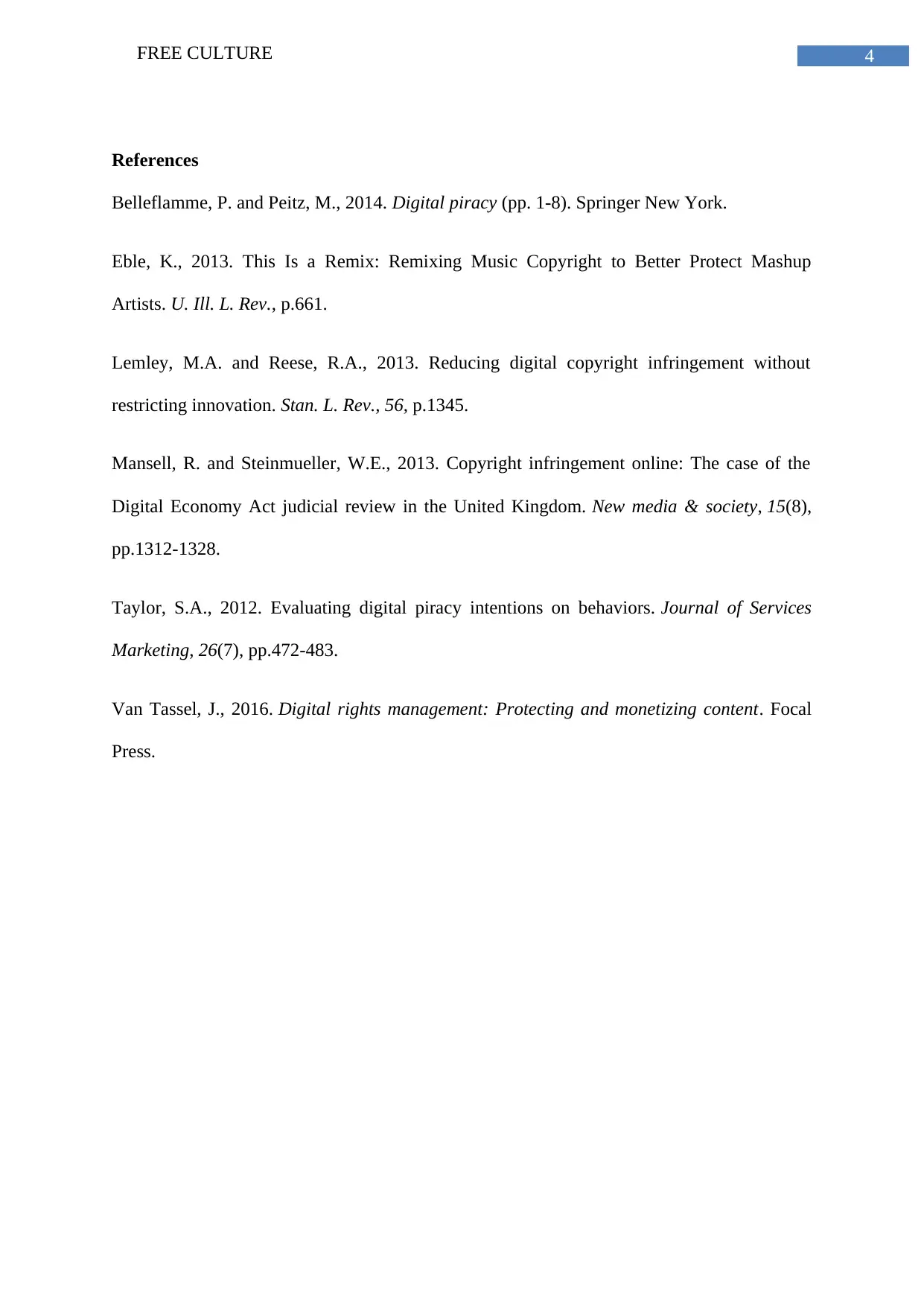
4FREE CULTURE
References
Belleflamme, P. and Peitz, M., 2014. Digital piracy (pp. 1-8). Springer New York.
Eble, K., 2013. This Is a Remix: Remixing Music Copyright to Better Protect Mashup
Artists. U. Ill. L. Rev., p.661.
Lemley, M.A. and Reese, R.A., 2013. Reducing digital copyright infringement without
restricting innovation. Stan. L. Rev., 56, p.1345.
Mansell, R. and Steinmueller, W.E., 2013. Copyright infringement online: The case of the
Digital Economy Act judicial review in the United Kingdom. New media & society, 15(8),
pp.1312-1328.
Taylor, S.A., 2012. Evaluating digital piracy intentions on behaviors. Journal of Services
Marketing, 26(7), pp.472-483.
Van Tassel, J., 2016. Digital rights management: Protecting and monetizing content. Focal
Press.
References
Belleflamme, P. and Peitz, M., 2014. Digital piracy (pp. 1-8). Springer New York.
Eble, K., 2013. This Is a Remix: Remixing Music Copyright to Better Protect Mashup
Artists. U. Ill. L. Rev., p.661.
Lemley, M.A. and Reese, R.A., 2013. Reducing digital copyright infringement without
restricting innovation. Stan. L. Rev., 56, p.1345.
Mansell, R. and Steinmueller, W.E., 2013. Copyright infringement online: The case of the
Digital Economy Act judicial review in the United Kingdom. New media & society, 15(8),
pp.1312-1328.
Taylor, S.A., 2012. Evaluating digital piracy intentions on behaviors. Journal of Services
Marketing, 26(7), pp.472-483.
Van Tassel, J., 2016. Digital rights management: Protecting and monetizing content. Focal
Press.
1 out of 5
Related Documents
Your All-in-One AI-Powered Toolkit for Academic Success.
+13062052269
info@desklib.com
Available 24*7 on WhatsApp / Email
![[object Object]](/_next/static/media/star-bottom.7253800d.svg)
Unlock your academic potential
Copyright © 2020–2025 A2Z Services. All Rights Reserved. Developed and managed by ZUCOL.





